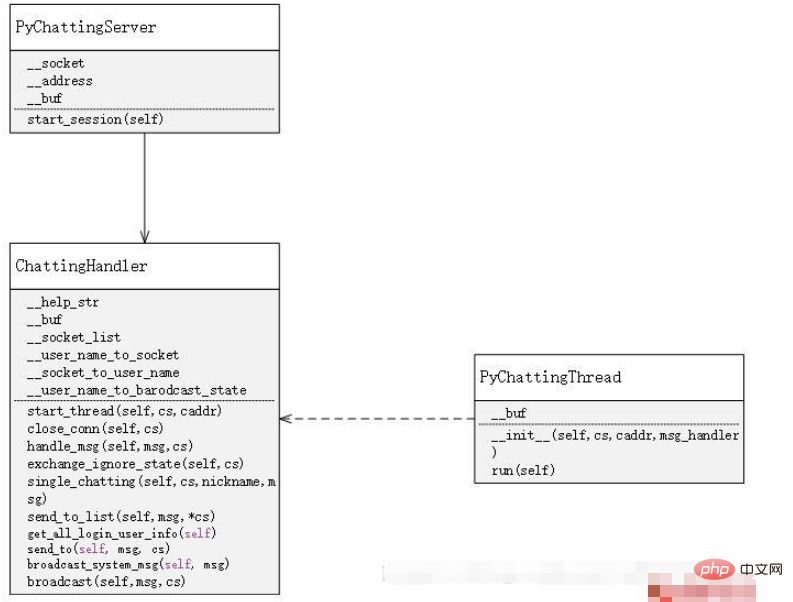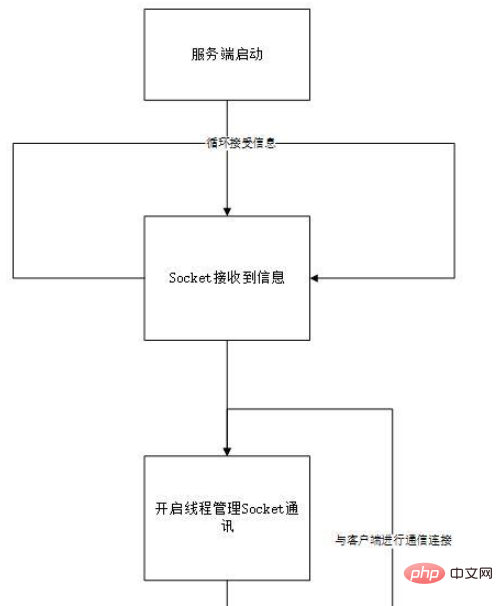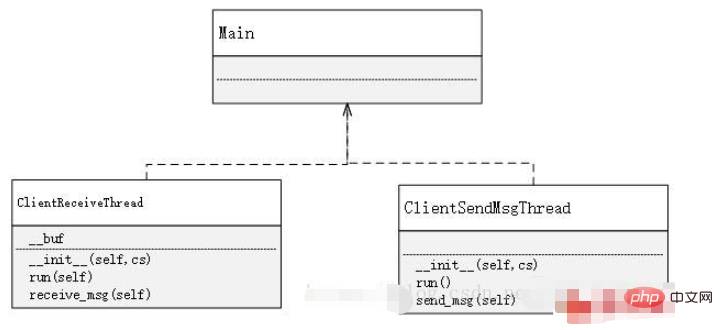Tutorial on writing a simple chat program in Python
Implementation ideas
x01 Establishment of the server
First, on the server side, use socket to accept messages. Every time a socket request is accepted, a socket is opened. A new thread is used to manage the distribution and acceptance of messages. At the same time, there is a handler to manage all threads, thereby realizing the processing of various functions of the chat room
x02 Establishment of the client
The establishment of the client is much simpler than the server. The function of the client is only to send and receive messages, and to enter specific characters according to specific rules to achieve the use of different functions. Therefore, in On the client side, you only need to use two threads, one is dedicated to receiving messages, and the other is dedicated to sending messages. As for why not use one, that is because, if you only use one, then After receiving a message, the one that receives the message is in a blocked state before sending it. Similarly, the same is true for sending a message. If these two functions are implemented in one place, it will make it impossible to continuously send or receive messages.
Implementation method
Server-side implementation

import json
import threading
from socket import *
from time import ctime
class PyChattingServer:
__socket = socket(AF_INET, SOCK_STREAM, 0)
__address = ('', 12231)
__buf = 1024
def __init__(self):
self.__socket.bind(self.__address)
self.__socket.listen(20)
self.__msg_handler = ChattingHandler()
def start_session(self):
print('等待客户连接...\r\n')
try:
while True:
cs, caddr = self.__socket.accept()
# 利用handler来管理线程,实现线程之间的socket的相互通信
self.__msg_handler.start_thread(cs, caddr)
except socket.error:
pass
class ChattingThread(threading.Thread):
__buf = 1024
def __init__(self, cs, caddr, msg_handler):
super(ChattingThread, self).__init__()
self.__cs = cs
self.__caddr = caddr
self.__msg_handler = msg_handler
# 使用多线程管理会话
def run(self):
try:
print('...连接来自于:', self.__caddr)
data = '欢迎你到来PY_CHATTING!请输入你的很cooooool的昵称(不能带有空格哟`)\r\n'
self.__cs.sendall(bytes(data, 'utf-8'))
while True:
data = self.__cs.recv(self.__buf).decode('utf-8')
if not data:
break
self.__msg_handler.handle_msg(data, self.__cs)
print(data)
except socket.error as e:
print(e.args)
pass
finally:
self.__msg_handler.close_conn(self.__cs)
self.__cs.close()
class ChattingHandler:
__help_str = "[ SYSTEM ]\r\n" \
"输入/ls,即可获得所有登陆用户信息\r\n" \
"输入/h,即可获得帮助\r\n" \
"输入@用户名 (注意用户名后面的空格)+消息,即可发动单聊\r\n" \
"输入/i,即可屏蔽群聊信息\r\n" \
"再次输入/i,即可取消屏蔽\r\n" \
"所有首字符为/的信息都不会发送出去"
__buf = 1024
__socket_list = []
__user_name_to_socket = {}
__socket_to_user_name = {}
__user_name_to_broadcast_state = {}
def start_thread(self, cs, caddr):
self.__socket_list.append(cs)
chat_thread = ChattingThread(cs, caddr, self)
chat_thread.start()
def close_conn(self, cs):
if cs not in self.__socket_list:
return
# 去除socket的记录
nickname = "SOMEONE"
if cs in self.__socket_list:
self.__socket_list.remove(cs)
# 去除socket与username之间的映射关系
if cs in self.__socket_to_user_name:
nickname = self.__socket_to_user_name[cs]
self.__user_name_to_socket.pop(self.__socket_to_user_name[cs])
self.__socket_to_user_name.pop(cs)
self.__user_name_to_broadcast_state.pop(nickname)
nickname += " "
# 广播某玩家退出聊天室
self.broadcast_system_msg(nickname + "离开了PY_CHATTING")
# 管理用户输入的信息
def handle_msg(self, msg, cs):
js = json.loads(msg)
if js['type'] == "login":
if js['msg'] not in self.__user_name_to_socket:
if ' ' in js['msg']:
self.send_to(json.dumps({
'type': 'login',
'success': False,
'msg': '账号不能够带有空格'
}), cs)
else:
self.__user_name_to_socket[js['msg']] = cs
self.__socket_to_user_name[cs] = js['msg']
self.__user_name_to_broadcast_state[js['msg']] = True
self.send_to(json.dumps({
'type': 'login',
'success': True,
'msg': '昵称建立成功,输入/ls可查看所有在线的人,输入/help可以查看帮助(所有首字符为/的消息都不会发送)'
}), cs)
# 广播其他人,他已经进入聊天室
self.broadcast_system_msg(js['msg'] + "已经进入了聊天室")
else:
self.send_to(json.dumps({
'type': 'login',
'success': False,
'msg': '账号已存在'
}), cs)
# 若玩家处于屏蔽模式,则无法发送群聊消息
elif js['type'] == "broadcast":
if self.__user_name_to_broadcast_state[self.__socket_to_user_name[cs]]:
self.broadcast(js['msg'], cs)
else:
self.send_to(json.dumps({
'type': 'broadcast',
'msg': '屏蔽模式下无法发送群聊信息'
}), cs)
elif js['type'] == "ls":
self.send_to(json.dumps({
'type': 'ls',
'msg': self.get_all_login_user_info()
}), cs)
elif js['type'] == "help":
self.send_to(json.dumps({
'type': 'help',
'msg': self.__help_str
}), cs)
elif js['type'] == "sendto":
self.single_chatting(cs, js['nickname'], js['msg'])
elif js['type'] == "ignore":
self.exchange_ignore_state(cs)
def exchange_ignore_state(self, cs):
if cs in self.__socket_to_user_name:
state = self.__user_name_to_broadcast_state[self.__socket_to_user_name[cs]]
if state:
state = False
else:
state = True
self.__user_name_to_broadcast_state.pop(self.__socket_to_user_name[cs])
self.__user_name_to_broadcast_state[self.__socket_to_user_name[cs]] = state
if self.__user_name_to_broadcast_state[self.__socket_to_user_name[cs]]:
msg = "通常模式"
else:
msg = "屏蔽模式"
self.send_to(json.dumps({
'type': 'ignore',
'success': True,
'msg': '[TIME : %s]\r\n[ SYSTEM ] : %s\r\n' % (ctime(), "模式切换成功,现在是" + msg)
}), cs)
else:
self.send_to({
'type': 'ignore',
'success': False,
'msg': '切换失败'
}, cs)
def single_chatting(self, cs, nickname, msg):
if nickname in self.__user_name_to_socket:
msg = '[TIME : %s]\r\n[ %s CHATTING TO %s ] : %s\r\n' % (
ctime(), self.__socket_to_user_name[cs], nickname, msg)
self.send_to_list(json.dumps({
'type': 'single',
'msg': msg
}), self.__user_name_to_socket[nickname], cs)
else:
self.send_to(json.dumps({
'type': 'single',
'msg': '该用户不存在'
}), cs)
print(nickname)
def send_to_list(self, msg, *cs):
for i in range(len(cs)):
self.send_to(msg, cs[i])
def get_all_login_user_info(self):
login_list = "[ SYSTEM ] ALIVE USER : \r\n"
for key in self.__socket_to_user_name:
login_list += self.__socket_to_user_name[key] + ",\r\n"
return login_list
def send_to(self, msg, cs):
if cs not in self.__socket_list:
self.__socket_list.append(cs)
cs.sendall(bytes(msg, 'utf-8'))
def broadcast_system_msg(self, msg):
data = '[TIME : %s]\r\n[ SYSTEM ] : %s\r\n' % (ctime(), msg)
js = json.dumps({
'type': 'system_msg',
'msg': data
})
# 屏蔽了群聊的玩家也可以获得系统的群发信息
for i in range(len(self.__socket_list)):
if self.__socket_list[i] in self.__socket_to_user_name:
self.__socket_list[i].sendall(bytes(js, 'utf-8'))
def broadcast(self, msg, cs):
data = '[TIME : %s]\r\n[%s] : %s\r\n' % (ctime(), self.__socket_to_user_name[cs], msg)
js = json.dumps({
'type': 'broadcast',
'msg': data
})
# 没有的登陆的玩家无法得知消息,屏蔽了群聊的玩家也没办法获取信息
for i in range(len(self.__socket_list)):
if self.__socket_list[i] in self.__socket_to_user_name \
and self.__user_name_to_broadcast_state[self.__socket_to_user_name[self.__socket_list[i]]]:
self.__socket_list[i].sendall(bytes(js, 'utf-8'))
def main():
server = PyChattingServer()
server.start_session()
main()
 Client-side implementation
Client-side implementation

import json
import threading
from socket import *
is_login = False
is_broadcast = True
class ClientReceiveThread(threading.Thread):
__buf = 1024
def __init__(self, cs):
super(ClientReceiveThread, self).__init__()
self.__cs = cs
def run(self):
self.receive_msg()
def receive_msg(self):
while True:
msg = self.__cs.recv(self.__buf).decode('utf-8')
if not msg:
break
js = json.loads(msg)
if js['type'] == "login":
if js['success']:
global is_login
is_login = True
print(js['msg'])
elif js['type'] == "ignore":
if js['success']:
global is_broadcast
if is_broadcast:
is_broadcast = False
else:
is_broadcast = True
print(js['msg'])
else:
if not is_broadcast:
print("[现在处于屏蔽模式]")
print(js['msg'])
class ClientSendMsgThread(threading.Thread):
def __init__(self, cs):
super(ClientSendMsgThread, self).__init__()
self.__cs = cs
def run(self):
self.send_msg()
# 根据不同的输入格式来进行不同的聊天方式
def send_msg(self):
while True:
js = None
msg = input()
if not is_login:
js = json.dumps({
'type': 'login',
'msg': msg
})
elif msg[0] == "@":
data = msg.split(' ')
if not data:
print("请重新输入")
break
nickname = data[0]
nickname = nickname.strip("@")
if len(data) == 1:
data.append(" ")
js = json.dumps({
'type': 'sendto',
'nickname': nickname,
'msg': data[1]
})
elif msg == "/help":
js = json.dumps({
'type': 'help',
'msg': None
})
elif msg == "/ls":
js = json.dumps({
'type': 'ls',
'msg': None
})
elif msg == "/i":
js = json.dumps({
'type': 'ignore',
'msg': None
})
else:
if msg[0] != '/':
js = json.dumps({
'type': 'broadcast',
'msg': msg
})
if js is not None:
self.__cs.sendall(bytes(js, 'utf-8'))
def main():
buf = 1024
# 改变这个的地址,变成服务器的地址,那么只要部署到服务器上就可以全网使用了
address = ("127.0.0.1", 12231)
cs = socket(AF_INET, SOCK_STREAM, 0)
cs.connect(address)
data = cs.recv(buf).decode("utf-8")
if data:
print(data)
receive_thread = ClientReceiveThread(cs)
receive_thread.start()
send_thread = ClientSendMsgThread(cs)
send_thread.start()
while True:
pass
main()The above is the detailed content of Tutorial on writing a simple chat program in Python. For more information, please follow other related articles on the PHP Chinese website!

Hot AI Tools

Undress AI Tool
Undress images for free

Undresser.AI Undress
AI-powered app for creating realistic nude photos

AI Clothes Remover
Online AI tool for removing clothes from photos.

ArtGPT
AI image generator for creative art from text prompts.

Stock Market GPT
AI powered investment research for smarter decisions

Hot Article

Hot Tools

Notepad++7.3.1
Easy-to-use and free code editor

SublimeText3 Chinese version
Chinese version, very easy to use

Zend Studio 13.0.1
Powerful PHP integrated development environment

Dreamweaver CS6
Visual web development tools

SublimeText3 Mac version
God-level code editing software (SublimeText3)
 How to install packages from a requirements.txt file in Python
Sep 18, 2025 am 04:24 AM
How to install packages from a requirements.txt file in Python
Sep 18, 2025 am 04:24 AM
Run pipinstall-rrequirements.txt to install the dependency package. It is recommended to create and activate the virtual environment first to avoid conflicts, ensure that the file path is correct and that the pip has been updated, and use options such as --no-deps or --user to adjust the installation behavior if necessary.
 How to test Python code with pytest
Sep 20, 2025 am 12:35 AM
How to test Python code with pytest
Sep 20, 2025 am 12:35 AM
Python is a simple and powerful testing tool in Python. After installation, test files are automatically discovered according to naming rules. Write a function starting with test_ for assertion testing, use @pytest.fixture to create reusable test data, verify exceptions through pytest.raises, supports running specified tests and multiple command line options, and improves testing efficiency.
 How to handle command line arguments in Python
Sep 21, 2025 am 03:49 AM
How to handle command line arguments in Python
Sep 21, 2025 am 03:49 AM
Theargparsemoduleistherecommendedwaytohandlecommand-lineargumentsinPython,providingrobustparsing,typevalidation,helpmessages,anderrorhandling;usesys.argvforsimplecasesrequiringminimalsetup.
 What is BIP? Why are they so important to the future of Bitcoin?
Sep 24, 2025 pm 01:51 PM
What is BIP? Why are they so important to the future of Bitcoin?
Sep 24, 2025 pm 01:51 PM
Table of Contents What is Bitcoin Improvement Proposal (BIP)? Why is BIP so important? How does the historical BIP process work for Bitcoin Improvement Proposal (BIP)? What is a BIP type signal and how does a miner send it? Taproot and Cons of Quick Trial of BIP ConclusionAny improvements to Bitcoin have been made since 2011 through a system called Bitcoin Improvement Proposal or “BIP.” Bitcoin Improvement Proposal (BIP) provides guidelines for how Bitcoin can develop in general, there are three possible types of BIP, two of which are related to the technological changes in Bitcoin each BIP starts with informal discussions among Bitcoin developers who can gather anywhere, including Twi
 From beginners to experts: 10 must-have free public dataset websites
Sep 15, 2025 pm 03:51 PM
From beginners to experts: 10 must-have free public dataset websites
Sep 15, 2025 pm 03:51 PM
For beginners in data science, the core of the leap from "inexperience" to "industry expert" is continuous practice. The basis of practice is the rich and diverse data sets. Fortunately, there are a large number of websites on the Internet that offer free public data sets, which are valuable resources to improve skills and hone your skills.
 How can you create a context manager using the @contextmanager decorator in Python?
Sep 20, 2025 am 04:50 AM
How can you create a context manager using the @contextmanager decorator in Python?
Sep 20, 2025 am 04:50 AM
Import@contextmanagerfromcontextlibanddefineageneratorfunctionthatyieldsexactlyonce,wherecodebeforeyieldactsasenterandcodeafteryield(preferablyinfinally)actsas__exit__.2.Usethefunctioninawithstatement,wheretheyieldedvalueisaccessibleviaas,andthesetup
 How to choose a computer that is suitable for big data analysis? Configuration Guide for High Performance Computing
Sep 15, 2025 pm 01:54 PM
How to choose a computer that is suitable for big data analysis? Configuration Guide for High Performance Computing
Sep 15, 2025 pm 01:54 PM
Big data analysis needs to focus on multi-core CPU, large-capacity memory and tiered storage. Multi-core processors such as AMDEPYC or RyzenThreadripper are preferred, taking into account the number of cores and single-core performance; memory is recommended to start with 64GB, and ECC memory is preferred to ensure data integrity; storage uses NVMeSSD (system and hot data), SATASSD (common data) and HDD (cold data) to improve overall processing efficiency.
 How to write automation scripts for daily tasks in Python
Sep 21, 2025 am 04:45 AM
How to write automation scripts for daily tasks in Python
Sep 21, 2025 am 04:45 AM
Identifyrepetitivetasksworthautomating,suchasorganizingfilesorsendingemails,focusingonthosethatoccurfrequentlyandtakesignificanttime.2.UseappropriatePythonlibrarieslikeos,shutil,glob,smtplib,requests,BeautifulSoup,andseleniumforfileoperations,email,w





